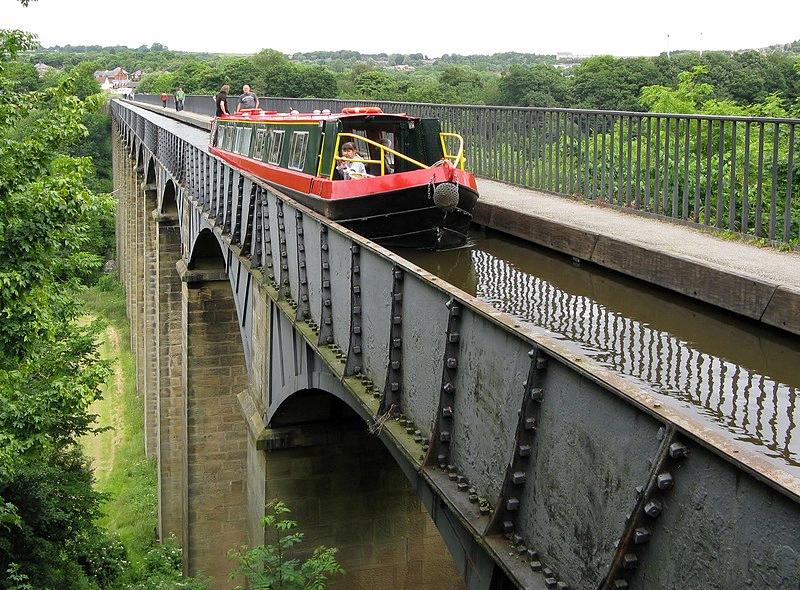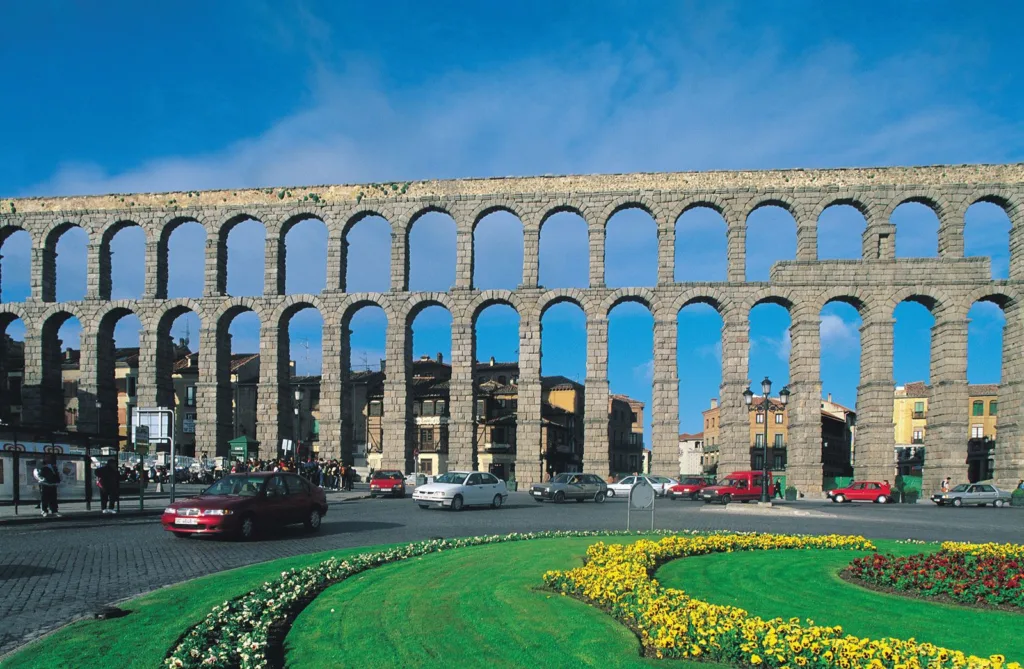Aqueducts are an ingenious invention that has been used throughout history to transport water from one place to another. The Romans were particularly skilled at building aqueducts, and they used them to supply water to teir cities, towns, and farms. But how exactly do aqueducts work?
The first step in building an aqueduct is to identify a source of water. This could be a river, lake, or spring. In the case of the Roman aqueducts, most of the water came from springs in the Anio valley and the surrounding uplands. Once a source of water has been identified, the next step is to build a channel to transport the water.
The channel is typically made of stone, concrete, or a combination of the two. It is designed to be as straight as possible, with a gradual slope to ensure that the water flows smoothly. The channel is also designed to be as level as possible, to avoid unnecessary drops or rises in the water level.
One of the challenges of building an aqueduct is that it often needs to cross valleys or other low-lying areas. In these cases, the channel is built in the form of an arch, which allows it to span the gap. The arch is a strong and stable shape that can support a lot of weight, making it ideal for aqueducts.
When the channel needs to cross a particularly deep valley, a siphon is used. A siphon is a U-shaped tube that is buried underground. The water flows down one side of the U, then up the other side. The force of the water flowing downhill is enough to push the water uphill on the other side of the siphon. This allows the water to cross the valley without the need for a high bridge or other structure.
Along the length of the channel, there are usually several structures that are used to regulate the flow of water. These can include weirs, which are low walls that help to control the flow of water, and gates, which can be opened or closed to allow more or less water to flow through the channel.
At the end of the aqueduct, the water is collected in a reservoir or cistern. From there, it can be distributed to the people who need it.
Aqueducts are an important way to transport water from one place to another. They are typically made of stone or concrete and are designed to be as straight and level as possible. When they need to cross a valley, a siphon is used to allow the water to flow uphill. Along the length of the channel, there are structures to regulate the flow of water. At the end of the aqueduct, the water is collected in a reservoir or cistern, ready for distribution.
The Process of Water Entering Aqueducts
Aqueducts were an essential part of the water supply system in ancient Rome, which transported fresh water from various sources to the city. The primary source of water for aqueducts was springs, which were located in the uplands and valleys surrounding Rome.
To transport the spring water into the aqueducts, the Romans built springhouses made of stone or concrete. The springhouses were constructed around the springs to collect and regulate the water flow. The collected water then flowed through a channel or conduit connected to the springhouse.
The conduit was typically made of concrete or stone and was built above ground, following the natural contours of the terrain. The conduit was designed with a slight slope to ensure that the water flowed continuously towards the city.
In some cases, the aqueducts were built with an inverted siphon, which allowed the water to be transported over valleys or low-lying areas. An inverted siphon consisted of a U-shaped section of the conduit, which allowed the water to flow up and over the valley befoe descending to the other side.
Once the water entered the aqueduct conduit, it was transported to the city where it was distributed to public fountains and baths, as well as private homes. The aqueducts were an engineering marvel that allowed Rome to thrive and grow, and they remain a testament to the ingenuity and skill of the ancient Romans.
To summarize, water gets into aqueducts through the collection of spring water into a springhouse, which then flows into a concrete or stone conduit that transports the water to the city.

Source: en.wikipedia.org
How Aqueducts Work Uphill
Aqueducts are structures that were built to transport water from one place to another. They were used extensively by ancient civilizations and continue to be used today in various parts of the world. But how exactly do aqueducts work when they have to transport water uphill?
To understand this, we need to look at the structure of an aqueduct. Aqueducts are typically built with a gentle slope, so that the water flows downhill naturally. But when the pipes have to span a valley or go over a hill, a siphon is used to transport the water uphill.
A siphon is a U-shaped pipe that dips down into a valley or dips below the ground and then rises up again to the other side. When water flows through a siphon, it drops quickly, creating momentum that allows it to travel uphill. This is posible due to the principle of atmospheric pressure.
The water in the siphon is under atmospheric pressure, which means that it is under the same pressure as the air around it. However, when the water drops down into the valley, the pressure inside the siphon decreases. This creates a vacuum, which pulls the water up the other side of the valley and over the hill.
To ensure that the siphon works properly, it must be carefully designed with the correct slope and dimensions. The pipes must be large enough to allow the water to flow freely, but not so large that the water loses too much momentum. The siphon must also be carefully sealed to prevent air from entering and breaking the vacuum.
Aqueducts transport water uphill using siphons. These U-shaped pipes create a vacuum that allows water to flow uphill due to atmospheric pressure. The design of the siphon is critical to ensure that it works properly and efficiently.
Do Aqueducts Still Function as Water Carriers?
Aqueducts have been used for centuries to transport water from one place to another, and they stll continue to do so today. While some aqueducts have been abandoned or fallen into disrepair, many others are still in use around the world.
In modern times, aqueducts are often used to transport water from remote or mountainous areas to urban centers where it is needed for drinking, irrigation, and other purposes. They may also be used to transport water to industrial facilities, power plants, or other sites that require large amounts of water.
One example of a modern aqueduct is the California Aqueduct, which was completed in 1972 and is used to transport water from the Sierra Nevada mountains to the cities and farms of Southern California. The aqueduct spans over 400 miles and is capable of transporting up to 13 billion gallons of water per day.
Another example is the Canal de Isabel II, which is located in Madrid, Spain. This aqueduct was built in the mid-19th century and is still in use today, supplying water to the city and surrounding areas.
While some aqueducts may no longer be in use, many others are still carrying water and serving important roles in providing water to communities and industries around the world.
The Benefits of Aqueducts Using Arches
Aqueducts are structures that were used in ancient times to transport water from one place to another. These structures were crucial in providing water for drinking, irrigation, and other purposes. One of the most remarkable features of aqueducts is the use of arches in their design.
Arches were an innovative way to build stronger structures using less material, and they were widely used in ancient times. They not only added style to structures but also enabled them to support far more weight than other shapes.
The use of arches in aqueducts was particularly important as it allowed the structures to span valleys and other obstacles, which would have been impossible with other designs. The arches distributed the weight of the water and the structure evenly, preventing any one point from becoming overloaded and breaking.
Moreover, the use of arches in aqueducts allowed for a more efficient flow of water. The arches cold be built at different heights, allowing the water to flow downhill without the need for pumps or other mechanical devices. This made the transport of water much easier and more cost-effective.
Aqueducts have arches because they were a highly effective and efficient way to build strong structures that could transport water over long distances while minimizing the amount of material needed. The use of arches also allowed for a more efficient flow of water, making aqueducts an essential part of ancient water management systems.

Conclusion
Aqueducts are a remarkable feat of engineering that allowed ancient civilizations to transport water over long distances. By using gravity and siphons, they were able to move water efficiently and effectively, improving the health and quality of life for many people. The use of arches in aqueduct construction was a game-changer, allowing for stronger and more stable structures. Today, aqueducts continue to be an important way of providing water to communities around the world. The ingenuity and innovation of ancient engineers continue to inspire and influence modern-day infrastructure design.
